Text
Curios: Jasper Park
An investigative horror mystery experience by Seb Pines
After rummaging through the treasure chest that was Curios: Albrecht Manor by Seb Pines last year, I finally sat down to open Jasper Park, the second installment of the Curios series, and wasn't disappointed. This time, you're investigating the disappearance of a group of hikers in Jasper National Park - have they simply fallen prey to nature's dangers or is there more behind this mysterious case?

I'll be honest - I don't think writing a review like I usually do makes a lot of sense (although chrisairgames did a great job with Albrecht Manor). Most of this experience hinges on you going through the materials and puzzling together the events yourself. For me, these feel like elaborate, kinda multimedia novellas for a cozy evening alone or in a group. The appeal is definitely in the "supernatural office job"-vibes, which is also why I don't have my Albrecht Manor notes anymore (it was so good, I repackaged everything and sent it to a friend to get a "professional second opinion" - expecting heated exchanges of theories soon). Aside from that all I could actually talk about is the story itself and I'd rather you discover it on your own.

The care and artistry put into the materials is top notch. Jasper Park pulled me in even more than Albrecht Manor did, perhaps because this has a more pronounced "official investigation" vibe and a lot more perspectives to offer from other characters and sources. Thankfully, both games stand on their own - I think I'd even recommend starting with Jasper Park at this point. Admittedly, you don't actually have to cover your entire living room floor in clues like some poor man's conspiracy board, but it was a lot of fun. Also incredibly creepy.
So - no review. But a big fat endorsement. I really hope there'll be more installments, because this type of game/experience/story ticks all my personal boxes. You can see some pictures after the cut, if you're not too afraid of tiny spoilers.
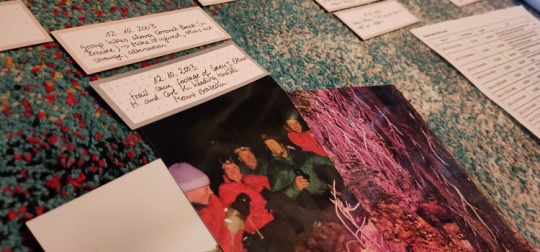

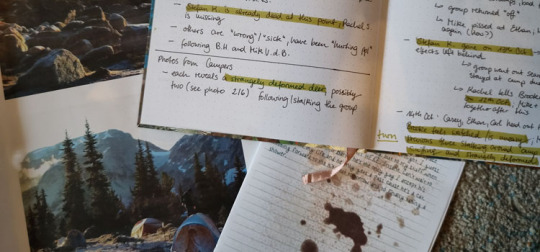
Also a picture of what the whole thing looked like in the end (minus the last two entries, which i had to fit on the couch). So small you can't read the text and so less danger of spoiling it for yourself, but if you're curious:
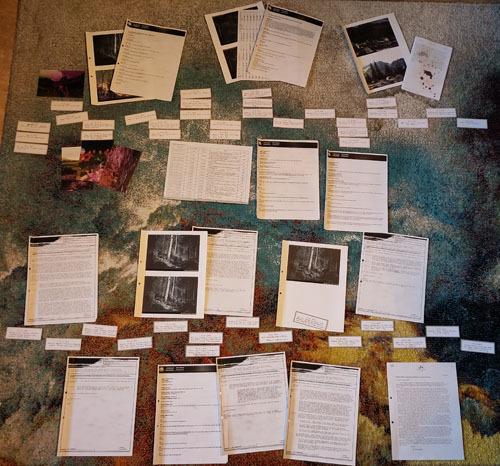
#indie ttrpg#solo rpg#beginner friendly#mid#mystery#horror#multimedia#playthrough#(kinda)#curios#curious: jasper park
9 notes
·
View notes
Text
Time to Play Curios: Albrecht Manor
When it's Halloween, I like to play creepy Halloweenie games. Ok, well I might like spooky games all year-round, but for the horror season it's time to pull out all stops. When I received this package in the mail last month, I knew it'd be perfect for the weekend before Halloween:

Curios: Albrecht Manor is "an epistolary horror mystery experience" by Seb Pines, the first in the new Curios series from Good Luck Press. There is no single person who runs the game. No one knows what they're about to open, other than what you see on the blurb.
The notion of the game is that the players are "Researchers" of "The Archive" who receive evidence and ephemera leftover after the appearance of supernatural phenomena. The details on the Archive is sparse, but you an unbothered dayjob vibe oozes from the tone. This manila envelope is all you're going to get, and your job is to make some declarative statements by the end of the research.
It's a fun space to play. I could see the experience of play spanning the spectrum between a total LARP and completely player-facing. For our game, we were closer to the player-facing end of that spectrum, and had a fabulous evening.
What's inside?
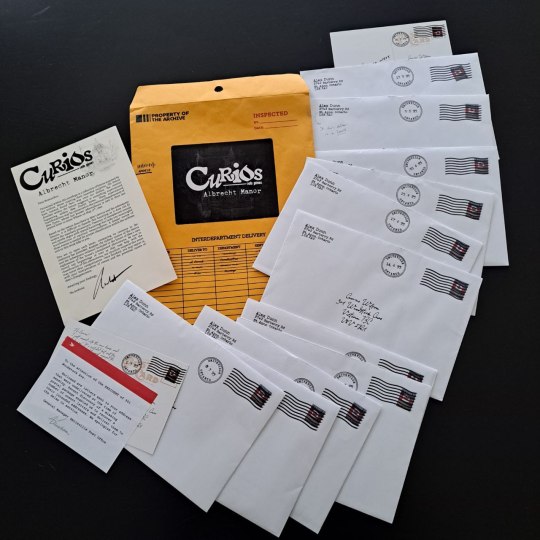
The Albrecht Manor manila envelope contains 11 letters and two postcards, along with a short mailing notice and the "Archive" report card. Like any good horror story, the letters start off tame with bits of weird, yet quickly start including photos, newspaper snippets, blueprints and administrative papers.
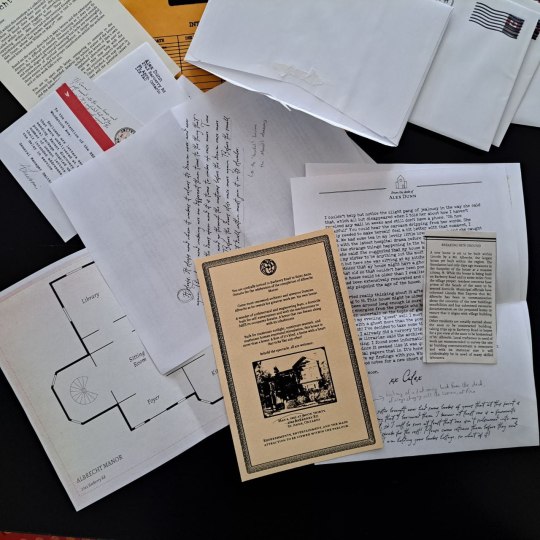
From tearing open the letters to the difference in paper textures, styles and handwritten bits were thrilling to handle. We were surprised how each piece, and sometimes innocuous details at first, came back to have us rifling back through what we'd read before.
Play Experience
With the stack of letters in the center of the table, without prior discussion, we naturally began to play by each picking up a letter/postcard, and circling, writing notes, and sharing weird details. This created a fun, anachronistic revelation of details, as sometimes one bit would go unremarked earlier would pop up in someone else's letters.
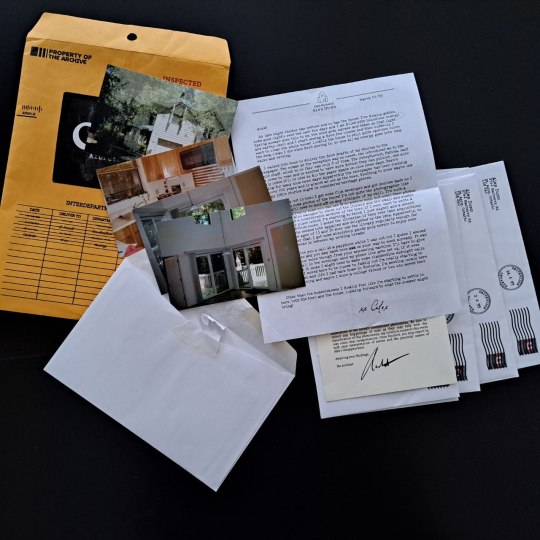
When an important detail came to the forefront of this developing narrative, I appreciated how the spotlight would pass around each of us adding more context or details or asking questions we weren't sure how to answer. But it's extremely difficult to discuss direct details without spoiling the contents of the letters. The discovery of certain documents and finding the inter-connectivity is the fun of this game.
The game comes with a single paragraph of instruction, which can seem daunting, but I was in awe of how the physical presentation made space for our own curiosity to define the bounds of how we approached the mystery. We examined photos under different types of lamplight, tried using the zoom on our smartphones as impromptu magnifying lenses, and folded paper in all sorts of ways. Most importantly, we were enraptured by this game for nearly three hours and were astonished at how fast the time passed.
We all appreciated how there is no direct, singular answer, and that we the players were the ones to define the story from our collective interpretation. It's not a good mystery, especially a ghost story mystery, if you're not left with more questions by the end.
Spoilers at the next heading!
Three specific moments literally gave me chills. I don't want to spoil those here. After the photo and line break is the report that was sent to the Archivist at curiosarchive.net. I realize now that we didn't "even "formally" discuss how we would classify the Albrecht Manor phenomena, but the classification is hinted at.
While I don't intend to spoil specific details in the letters, the submitted report has major spoilers. So if you haven't played this game, don't read any further!

Submitted Report to the Archivist
29/10/2023
Dear Archivist,
The first sentence on the first postcard, unwittingly, says it all, "the house is a dream."
This group of Archive researchers have deemed this household, built by one Damian Albrecht, to be a spiritual machine. This trap inhabits the mind of its occupants, and grows and shifts according to its creator's and past occupants' hopes and dreams of a warm household. The researchers are even hesitant to call this a haunting, but agree the house appears to be a spatio-temporal machination propelled by the spirits it is required to consume to keep operating. The fire, in this interpretation, is a convenient excuse for the house to re-enter its slumbering stasis. The researchers' consensus is that there must be only one true fire, but could not access WHEN that may be.
The researchers agreed, though without substantial evidence, the purpose of this machine is to sustain not only long life to its creator, Damian Albrecht, but also to impose HIS dream onto others, and subsume their dreams to feed his own. Again, the fire is a convenient cover-up for the displaced spirits Albrecht has trapped.
The researchers were divided on several facets, foremost questioning the actual existence of the principal figures: Alex Dunn and Anne Wilson. Could it be that Alex Dunn is in fact Albrecht? Has the persona of Alex Dunn created the character of Anne Wilson to represent the inhabitants of St. Ann? Will there be an all-consuming fire that destroys the town, and this house (and letters) are calling the community to action, as a sort of warning? Does Albrecht Manor's machinery twist and channel the powers of the Catholic Saint Ann, whose emblem is a Door, to imbue itself with supernatural power? If Alex Dunn is/was a real person, were they drawn to the house due to past trauma involving Anne and the implied kitchen fire that took place in the past? Did this oft-alluded-to fire kill Anne?
Many loose ends remain, but these Archive Researchers remain confident that the initial readings of the Albrecht Manor as deviating from the traditional haunting are correct. The "ghosts" are most likely Albrecht himself, and the temporal echoes of the Manor's past occupants. We put forth that through mechano-spiritual insights, "Damian Albrecht" built Albrecht Manor to trap people into its/his dreams of a perfect home. As a single household can never be "perfect" in his madness, the Manor and its master yearn to consume more ideals to feed this imperfect spiritual machine.
Thank you for reading, dear Archivist.
All best,
Chris Air & Friends.
#multimedia#epistolary#horror#mystery#mid#beginner friendly#review#ohhh so interesting to see how others approached this#have this in lieu of me having already passed on my copy of this excellent experience to a good friend to ask for their second opinion on#the case :)#curios#curios: albrecht manor#molly reblogs
19 notes
·
View notes
Text
Mini Reviews II
I don’t know what it is about space, but it makes me feel things. Have a handful of small and short games in space with a dash of emotional investment.
Low Battery by Batts
emotionally devastating :)
who doesn’t wanna be a little robot
play if you admire the attempt to create even under dire circumstances
One thing I love about solo experiences is that they really manage to get you into the head of other characters without any meddling from outside. This is especially true when mechanics and story/premise work together to get you there. Low Battery balances your character’s energy (Battery) and feelings (Melancholy, both signified by a D20 respectively) against the time that passes. With what little time you have left, can you find inspiration to create something? I was struggling with the D20s and watching the time and trying to decide on a move and – well, the robot is struggling, isn’t it? Struggling to stay conscious, to take in as much as it can for the time it has left in this universe and maybe, just maybe leaving something behind, something that proves it was here and tried to make a connection to the world around it. For me, time ran out too soon – but I still wrote a little poem about it:
Every time
We create something
It’s as if we chip off a tiny piece
Of the universe
As we see it
To carry around in our pocket.
You, an Astronaut by Hannah Shaffer and Evan Rowland
short, no prep required
an interactive narrative
more reflective than focused on a goal
This is a very short, narrative experience that I recommend reading with some suitable background music. Personally, this is right up my alley: you get a few choices to “sway” the narrative to your liking, which usually tells you something about yourself in the end. You are put into the shoes of an astronaut waking from their cryo-stasis due to their ship having veered off course and sending out a distress call. While you wait for an answer, you ruminate on your dreams and the memories connected to them. Similar to Low Battery, it sports a gorgeous layout that combines NASA images with the narrative, all put into a simple, retro-style mock-up of a spaceship UI. I don’t want to give away too much – it really is short. But I do feel that the themes of queerness and belonging come through strongly. Games like these either fit you like a glove or fall flat for you. For some reason, I was reminded of the Lifeline games, which I love dearly.
Letters to Europa by Lola Johnson
an exercise in self-reflection
a hopeful look into the future
relaxing and motivating
Epistolary games have their own special charm, perhaps because keeping in contact even when we’re far apart is something we’ve done forever as humans – this need to stay connected to someone we care about, no matter the odds. In the case of Letters to Europa, you write a message to a loved one on Europa, one of Jupiter’s moons. Messages take about a year to arrive, and thus are sent in packages all at once. After you’ve finished your package, you switch over to the other character, writing back to the person on Earth. This, to me, felt like a conversation with myself, first putting down my thoughts about the given prompt, then trying to get some distance and reflect on it through a positive lens. I took the prompts quite literally and went with how my last year has gone – kind of a mixed bag. The prompts for the Earthling seem a little more sombre, more morose. Just as the other character has left Earth, though, embodying them makes you leave that behind (and that’s what the game says, too, ‘give yourself permission to let […] go’). It settles you in a more optimistic mood, no matter how depressing your Earthling’s messages might have been. This is a tiny game that relies heavily on how willing you are to engage with it – but if you can, in whatever medium you choose, I think it’s quite effective.
10 notes
·
View notes
Text
Project Ecco
A solo roleplaying game by Elliot Davis
Materials
game manual
a planner, new or used
a coin/d2 and d6
materials to destroy your planner
further into play: additional coin and die, standard deck of cards, tarot deck
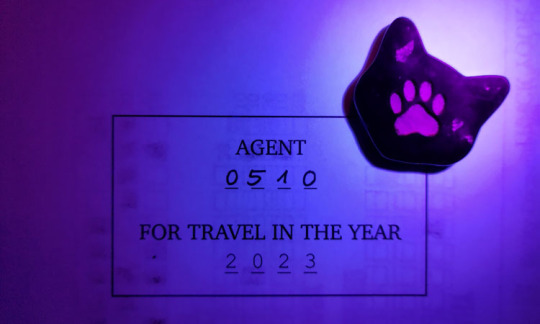
Premise
A mysterious agency, an even more mysterious entity feeding on time itself and smack-dab in the middle: You. As an extension of the Agency, you are tasked with uncovering the truth about “ECCO”, the Entity of Chronological Consumption and Obfuscation. Navigating the chaos of days flying by with the aid of a simple coin, will you complete your mission to the Agency’s satisfaction straightforwardly or will you travel down a road not yet taken, peeking behind a curtain of lies? Who is really on your side? Or, perhaps more importantly, on whose side are you?
Mechanics
In Project Ecco, you progress through time and the game using a regular planner and a variety of different time travel tools. While you might be tempted to use a brand new, untouched planner for this, a used one will do just fine and might even make the game more personal and varied, since existing notes or special dates can be incorporated into play. Keep in mind that your planner will end up at least partially destroyed by the Entity, then again the level of destruction is completely up to you. Scissors are certainly an option, but a good opaque paint marker achieves the same effect with less confetti.
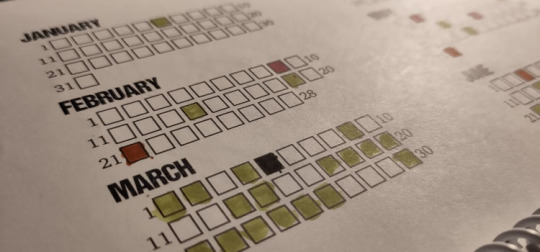
Your tools of choice are in essence a set of game oracles: prompts decided by dice, playing and tarot cards determine how far back or ahead in your planner you travel and which challenges you encounter along the way. Time travel can be quite random, so don’t be scared when you land on the same day more than once. At least as long as you have your trusty coin, the only thing that will keep you from slipping in-between time and experiencing some truly harrowing events. How you respond to these prompts is up to you. Write, draw, use planner stickers; the only limit is the space your planner gives you for the date you are currently on.

During your travels, you tally up the times you either make it back to the Agency or get uncomfortably close to the Entity. Entity encounters in particular are interesting because they prompt you to destroy random dates in your calendar, possibly forcing you into a timeline divergence later on. Completing six encounters either way triggers the endgame – but not necessarily the end of the journey…
Thoughts and Examples from my Playthrough
I had a lot of trouble trying to summarize the game in the above paragraphs. Project Ecco is a very meaty, complex (but not necessarily complicated) game and is more of a five-course meal than an afternoon snack. Consequently, reading the setup instructions can be a little intimidating for someone who has only started dabbling in solo play. Everything is explained thoroughly without being exhausting, however, and on top of that I found myself really interested to read about the different tools and mechanics. In fact, I had to stop myself from snooping too much so as not to spoil my first playthrough.

Your game can last you several sessions over a couple of days. Don’t worry, though, all the cool time travel tools make for a fresh and exciting experience. Special dates, timeline divergences, personal notes and Agency/Entity encounters also serve to keep you on your toes. Whenever you feel like you have seen it all, a new prompt throws you a curveball, altering your perspective on the world and its inhabitants. It’s also great for replayability purposes, as your first playthrough can influence how you go about the challenges on your second round. I usually don’t care much for replay value (my time is limited and there’s a lot of games to try out), in this case, however, it’s so on theme that it’s almost a crime not to play again.
When you have the general cycle down, the game is a breeze. Have I mentioned that I love the time travel devices? Each and every one is unique in the way it lets you progress. As soon as you pick them up during the game, you can switch freely between them. Either you are very strategic about it to avoid repeat visits to certain dates or you embrace chaos for some interesting results. In the beginning, I dreaded losing my coin and experiencing timeline divergences. The closer I got to the endgame, the more I revelled in the wild and unpredictable element they brought to the game and the story that unfolded.

At this point, it shouldn’t amaze me that much how game designers manage to achieve this impeccable level of worldbuilding with just a bit of flavour text and a handful of prompts. From the agents’ designations being real world dates to the time travel tools with clear retro vibes, Project Ecco lets you dive into an 80s sci-fi flick with you as the protagonist torn between your fragile loyalty to the Agency and the conflicting discoveries you make about the Entity. I suppose if there was one thing you wanted to knock, it could be that this is not a very character-driven game. A lot of journaling games focus on the character you create, often as a stand-in for yourself, dealing with their emotions and feelings as they react to the events thrown at them. This is more of mystery thriller focused on plot than a character exploration game. Character creation is as simple as picking your agent designation and, if you’re using a personal planner and are very meticulous in adding dates specific to your character, weaving in details during the game. That being said, I did manage to spin this into a tragic queer romance…such is the nature of solo roleplaying. Hence, others might disagree on this with me, and that’s totally fine.

My attention span has been wavering lately, so I honestly didn’t expect to stick with this. But everything about Project Ecco drew me in. I love the manual that looks like a genuine little agent handbook and the details of the understated illustrations. A solid white-black-and-red colour scheme is always a classy choice. The prompts are descriptive enough to give you guidance and bits of lore without limiting you to a specific path. It’s simply an overall round and well-thought-out experience through and through. I’m a little peeved I didn’t get the Temporal Spread – Samantha Leigh was a guest writer for this specific time travel tool and I’ve been dying to get into their other games (especially Outliers, which seems to deal with adjacent themes), so I was looking forward to get a peek at their writing here. Alas, my agent just wasn’t destined to have it…perhaps the next one will.
I wonder how well this would hold up with a digital planner. Mostly, I am an analogue player when it comes to journaling games. I like how tactile it is and that you're creating an artifact of play to keep on your shelf, something very unique and often verging on if not being outright artistry. But the analogue format does (perhaps intentionally) limit your word count and thus keeps journaling rather short and to the point. I suppose a digital format would allow for more character development, if that is your goal. It would also extend your playtime – which is already significant as is. Still, certainly an interesting option, especially when you plan on playing more than twice.
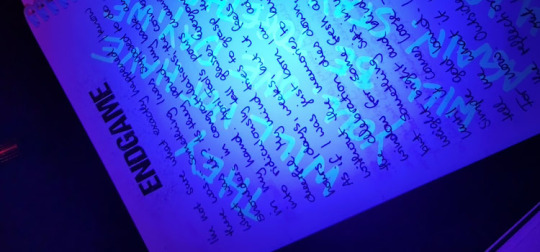
This might be your cup of coffee if...
you revel in a good time travel mystery.
you prefer to play longer games with more complex mechanics than the average journaling game.
you enjoy some solid worldbuilding and lore to add onto over time, possibly in multiple playthroughs.
you are not afraid to mess up some prime stationary. Seriously. If you love your planner? Do not use it for this. Bullet journaling queens and kings, beware!
You can get Elliot Davis’ Project Ecco HERE on itch.io or as a physical copy available at the online sources linked in the description of the game. Make sure to check out Cassi Mothwin’s flip through of the game and take in the incredible actual play episode by the My First Dungeon podcast crew that I enjoyed immensely and proves that this game supports a more light-hearted tone, as well. In case you are the creative type, Davis is currently still running a game jam for supplements for and games inspired by Project Ecco on itch.io that lasts until March 1st. Plenty of time left to get your head in the game. :)
43 notes
·
View notes
Text

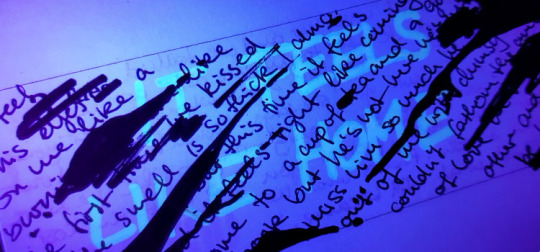


I played Project Ecco by Elliot Davis/@morebluebs!
6 notes
·
View notes
Text
First post- hello!
I noticed that tumblr has surprisingly little in the way of a solo ttrpg community, despite that seeming like exactly the type of hobby that this site lends itself toward?
I kept thinking how nice it would be if there were some sort of “hub” blog where people could share cool stuff from their solo game, find tips and resources, and otherwise explore the solo ttrpg hobby. Eventually I realized that I’d I wanted this blog to exist so much, I ought to make it myself.
Things here are still a work in progress, but I can’t wait to hear about your game! Any solo (or solo-curious) adventurer is welcome to join the guild.
Submissions: The Solo Adventurer's Guild welcomes submissions! If you would like to share a story from your solo game, a character or location that you are excited about, or really anything about your game at all; all I ask is that you include what game you're playing, and that you keep the submission PG-13.
299 notes
·
View notes
Text
Picks from the 12-word RPG Jam
The 12-word RPG Jam has ended and I rifled through all the beautiful submissions I missed during the last few busy weeks. Here’s a few of my personal favourites, but please do explore the list yourself if you have the time!
A word or two before we start: Micro RPGs are pretty diverse; some might work similarly to the games you are used to, others are more abstract and yet again others exist purely for the artistry of it. Try and give them a fair chance, even if they seem odd or cryptic at first. Personally, I like to see them as sort of interactive poetry (not that poetry in itself isn’t interactive, but maybe not specifically created to be interacted with in the same manner) or a recipe to aid your playful instinct. It might also be good to know that most of these are free or pay what you want, so the risk on your side is very low. 😉
Blorbo the Goblin by RatGrrrl Games
This adorable little guy is perfect for the tumblr crowd – WHAT about Blorbo the Goblin? I love that the inclusion of Blorbo in this specific meme environment immediately makes them relatable, as this format is usually reserved for slightly awkward situations or achievements that seem unimpressive to most people. Maybe Blorbo is really good at raising butterfly larvae or they can make the perfect scone – either way you feel empathetic right away and imagining a little story for them can fill a few minutes in your day. Adopt a new (but different) Blorbo today!
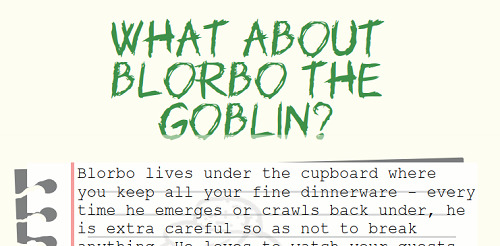
God Said Let Civilizations Grow by S. L.
To be super honest, I feel like I’m playing this game every week in my fridge…albeit not on purpose. Which is why this intrigues me so: break up some crackers in a bowl, pour water over and wait until something starts growing – either mould or, depending on your choice of cracker, the odd little sprout, if there’s seeds in there. Purposefully creating what most of us would just throw in the trash gives you another perspective on life, I feel like. A very meditative game that I haven’t tried yet, but will soon (yes, I’m dead serious).
Afungus by W. H. Arthur
While we are on the topic of fungi, have another one. Picking up on the Among Us mechanics (which aren’t original, either, but certainly gained inspiration from what the teens and kids once called “Mafia” and is now more widely known as “Werewolf”) and the current trend in putting mushrooms in everything, this is a fun twist on the formula and super easy to understand when you’re familiar with the concept. Best of all, this one is playable as a group! A great filler in between other games when you’re already seated at the table or perhaps something to do while you wait for your pizza to come out of the oven. I’m a sucker for puns, space settings and humour, so this is right up my alley.
Story in a Jar by Eliot Silvarian
Small items often go unnoticed after a while – your last holiday souvenir is probably collecting dust on a shelf somewhere as we speak! One man’s trash is another man’s treasure: slip into the role of a tiny person living in your own home and re-imagine the use of some of the trinkets, baubles and bric-a-brac you have lying around. That guitar pick you never use might make a durable tabletop, a pair of dried-up acorns could be holed out and repurposed as baskets and the hands on your broken wristwatch might still serve as chopsticks for someone so small. All you need is stuff from around your house and a way to record the little story you make up for your character. I have a soft spot for these low-prep, spontaneous creative exercises, plus they’re great when you have children around and need a distraction!

The Lazy Cartographer’s Guide by froggikit
I find that coming up with maps and locations can be harder than making up characters and while there’s a bunch of map-making software out there, they’re not always so easy to learn and/or accessible to everyone. This is a simple and fast way to generate a quick analogue map if you need one and might even be cool to use alongside another game (my first thought was it’s perfect for A Quiet Year). Just throw some dice, draw a wiggly line around them and interpret the numbers rolled for your trees, settlements and wondrous places. Another one that would be great in a group!
Some quick honourable mentions:
Uplifting! by Beth and Angel Make Games – a collection of 12-word RPGs meant to lift your spirit in your everyday life
Gesta orbital by La esquina del rol – a space survival game that’s pretty punishing and scary
Ominous Blessing by Junk Food Games – a collection of three mysterious and occult games for a spooky night alone or with friends
Endless Walk by From These Rolls – a reflective game about noticing your surroundings while you take a walk – or a character of your choosing
As you can see, the range is incredible: some are tools, some are ways to spark your imagination, others full-fledged games. I highly encourage you again to take some time and explore. Have fun!
14 notes
·
View notes
Text
Waffles for Esther
A solo journaling game by Pandion Games
Materials
game manual
a journal or other recording method
standard deck of cards, minus jokers
a set of polyhedral dice (or digital ones)
a coin
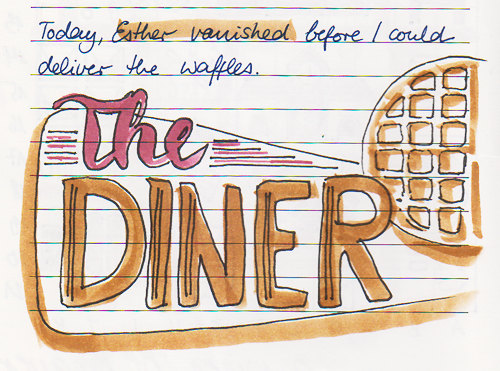
Premise
As the waitress of a small-town diner, your mission is to make every customer who sits down for a drink and a meal as happy as can be while trying to balance familiarity and professionalism juuust right. Among the regulars is Esther, who always comes in at the same time each day to order the same items from the menu: a coffee (one sugar and a splash of milk), the diner’s signature waffles (with two sliced strawberries and apple jam syrup on the side) and some hashbrowns (with extra ketchup). However, as you turn to deliver Esther’s waffles, she has gone missing – and as the pinnacle of customer service, you cannot have that! Embark on a mission to solve the mystery of Esther’s disappearance and ensure that she gets her waffles, preferably in one piece.
Mechanics
Waffles for Esther is based on a set of randomized prompts working together to help tell you a story, aided by a simple but effective skill check system.
You begin by setting up the game, giving your character a name and a bit of a background. It is also recommended that you create a personal connection to the town by drawing a map of the provided locations (or make up your own to change it up). Each round begins with you choosing a location to investigate and rolling on a random complication you encounter there. A skill check (Waitress and Detective, respectively a d12 and d10 at the beginning) determines your success – will you find a clue or will your inquiries into the mystery result in hilarious chaos? Clues are provided as a list of random items you draw from a standard deck of cards. The more clues you can gather during your hijinks, the better your chances of getting the conclusion right and solving the mystery, as the number of clues raises the value of the die you can roll in a final check at the end of your game.
While succeeding might seem easy at first, every time you fail a skill check reduces the value of the skill die you used – and you can only replenish your skills once! So, make sure to roll well…it’s for Esther, after all.

Thoughts and Examples from my Playthrough
What makes this premise work so well is the figure of Esther, our mystery woman, an almost blank canvas except for her meticulous order, and the backdrop of a small town – the perfect recipe for a cozy mystery adventure! Combined with some hilarious, charming and outrageous prompts, a set of clues that fit well together no matter their combination and a skill check system that had me on (a comfortable) edge at all times, this is an enjoyable ride for a night in or a few relaxing minutes each day. Clearly, some inspiration has been taken from your well-known mystery shows and books, think Nancy Drew and Miss Marple, with an emphasis on a light-hearted tone. I appreciate that safety advice has been added nevertheless – it’s good to remind players that they’re in charge of their game, even if it veers off into an unintended direction.
I’m honestly a little awkward still in roping prompts together, but should they not add up in the end, you are free to leave out clues you cannot link to the mystery (albeit you’ll miss out on raising the die value further for your final check). Even so, some of my fails were much funnier than my successes – a game that makes failing something you almost look forward to truly celebrates hijinks the right way. Some of my favourite results were:
being run over by the ancient mailman and taking an unintended bath in the town lake,
almost hitting the president of the book club over the head and promptly being excluded from the same,
vomiting into an urn at the funeral home…one that was already filled with some poor man’s ashes, and
ending up in a LARP, where my arrival prompted the story to turn into a time travel adventure.

The hints and hijinks system is, in my opinion, what makes this unique and entertaining. It’s not often that games find a way to utilize failed rolls in a way that makes sense for the premise of the game and gives the player more than a “whelp, that was nothing” to work with.
Although my Esther was a courageous woman who fought for the town’s well-being, your Esther might be a more nefarious one – who can say? The game leaves ample room for interpretation, handing you the tools to tell your own story without dumping all the hard work of finding ideas on you. Of course, the usual challenges of journaling games are present: ultimately, it depends on you how much fun you’ll have with the narrative. If you’re like me and have trouble coming up with connections, there’s always the option to play with someone else and bounce ideas off each other. Another fun variety might be to replace the default locations with some from your own town or simply make them more outrageous (an abandoned theme park, perhaps, or an animal shelter, a gay bar…).
Let’s not forget to mention the delicious little graphics included in the manual as well as the simple but effective layout. Can we appreciate the colour choices made? Everything serves the retro small-town vibe and I’m here for it. The versatility of the system has already spawned a game jam, which is always a good sign for if a system works or not. I think Pandion Games managed to make both a perfectly executed journaling game as well as an incredibly useful SRD and I hope to see and play more games in the same vein as Waffles for Esther for some time to come!

This might be your cup of coffee if...
you like to read and/or watch cozy mysteries.
you are not afraid of being proven wrong – and can revel in the funny consequences!
you long for something more casual and light-hearted to brighten up your day.
you appreciate a game with lower stakes, where you won’t have to save the world for once (but…you could, if you wanted to).
you want something with almost zero prep- and maximum hijinks-time.
You can get Pandion Game’s Waffles for Esther HERE on itch.io! Make sure to check out The Jester King’s Dance as well, a darker game based on the same mechanics, and the still running game jam to create your own contribution in the same vein!
#solo rpg#review#journal#cards#dice#mystery#slice-of-life#mid#beginner friendly#indie ttrpg#waffles for esther
54 notes
·
View notes
Text
5 Act Play
A solo journaling RPG by Kaden Ramstack
Materials
game manual
a journal or other recording method
deck of tarot cards or playing cards
(if you use playing cards) 1d6 and 1d20
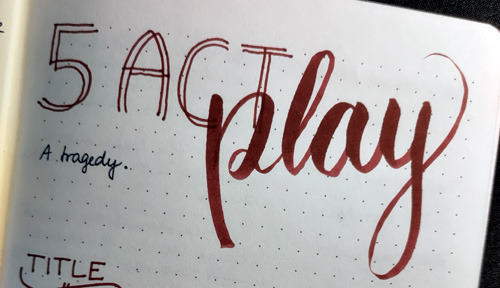
Premise
Channel your inner Shakespeare! Using a five-act structure, create your very own tragedy or comedy in the vein of the Bard of Avon: populate your play with colourful characters, give them motives and let them loose on each other. Whether you write a modern love story for the ages or a funny entertaining romp is all up to you.
Mechanics
This game is all about prompts inspiring and guiding you through the writing process of a five-act play (or more precisely: a summary of the same). Prompts are generated by drawing cards from your tarot deck or using the alternative playing cards and dice method. With the tarot deck, you alternate between drawing from the major arcana and suits. While the suits are tied to different motives and prompts depending on your progress throughout the play, the major arcana stand for themselves and need to be interpreted to inspire character creation, key parts of the narrative and ultimately the ending of your play. Sounds complicated? Don’t fret: with each step of the process comes a short but precise explanation of each part of the play as well as an example from a tragedy and a comedy each (”Much ado about nothing” and “Romeo and Juliet” respectively).
Thoughts and Examples from my Playthrough
5 Act Play is a clever little game that can entertain you for a lot of playthroughs. All the instructions are clearly worded and each step carefully thought out to enable you to write an actual play summary in under an hour. The prompts are inspired by Shakespeare’s plays and can serve both tragedies and comedies well, still requiring you to put some effort into interpreting and implementing them into your play. This can be a bit of a challenge sometimes: how do you put a death into your light-hearted comedy? Here, the examples come in extremely handy, as they feel carefully chosen to help you solve this exact problem (a death doesn’t always mean someone has to actually die - nothing is more fun than a fake death and a surprise return at just the right moment).
I hate to say this, but as a teacher I absolutely love the idea of mixing literary knowledge with a fun exercise in writing - this can be as much of a learning tool as it is a genuinely fun game. The layout, the explanations, the examples, the prompts all work together to give you a framework for your play and, almost as if it’s magic, you know what a five-act play is at the end, how it’s structured and how the plot usually progresses. I can also see this being a fun group activity with everyone creating plays individually and then reading them to each other or even crowning the Shakespeare of the day/evening. Basically, the role playing aspect is you being a writer writing a play, and there’s no better way to learn something than to try it out yourself.
Additionally, if you enjoy reading cards this is a great way to practice it: interpreting the cards based on the traditional meaning or using bits and pieces of their names and illustrations to build elements for your play, both approaches work just as well. I’m not too versed in tarot despite having had a deck since 6th grade, but it does feel like there was some thought put into which elements of the deck are used at each point in the game.

I played two times so far, the first playthrough to create a tragedy (”The Queen’s Right Hand”) and the second one to create a comedy (”The Dressmaker’s Happiness” - look, titles are hard). Now, I’m not a strong writer, so it takes me a bit to get into it and connect separate elements into a coherent story. But by the time I reached Act II the prompts simply fell into place, almost entirely on their own. The tragedy is about a Queen’s most valuable advisor, a reserved and controlled woman with the only goal to protect her ruler. When I created the antagonist, I didn’t quite know what to do with them, but drawing the motive card for “jealousy” made it clear that this is a tale of bitter and unrequited love on pretty much all sides - and then it almost wrote itself.
Is it an actually good play, though? Probably not. But games aren’t meant to produce a perfectly polished piece of writing (although they certainly can), they’re first and foremost meant to be fun. And I did have a lot of fun. So, goal accomplished. As always, you should try and make yourself comfortable in what you do. No one has to see what you write - indulge, be cringey, be cliché. I think that would even be on point for Shakespeare. Certainly by your second round you’ll feel more at ease: the comedy was a cute little romantic tale of deception, accidental kidnappings and a dressmaker who vowed to never marry falling in love with a socialite who lived under the thumb of her seemingly strict and gloomy uncle (with a duel in the middle - that one was a surprise even for me).
If you have trouble thinking of names for characters and places, I suggest having a few online name generators ready to help you out. It also works to use the cards as a guide: I drew “Strength” for one character and named him “Peter the Lion” because there’s a lion on the card...I mean. Do what you must.

I’d like to think Shakespeare would approve of this game. I very much do.
This might be your cup of coffee if...
you like telling stories and creating characters.
you want a relatively short writing challenge or exercise to flex your creative muscles.
you feel better having more of a framework to guide you in your writing.
you want to learn some literary theory on the side.
you are familiar with/want to get familiar with reading cards, specifically tarot.
You can get Kaden Ramstack’s 5 Act Play HERE on itch.io! Make sure to check out his other games as well (I for one really want to get to “Un-navigatable” soon).
3 notes
·
View notes
Text
Menagerie of the Void
A solo journaling game by Eran Aviram
Materials
game manual
index cards
pen, art supplies
journal or recording device
a deck of regular playing cards

Premise
You are the newly appointed keeper of an alien zoo whose systems are unintelligible to you. As you try to gain control over the system, you have to attend to the zoo’s new additions, creating habitats for them and making sure they settle in properly. However, more and more problems spring up the longer you try to keep the zoo running and its inhabitants alive. Will you succumb to the strange and mysterious workings of the machines or, in an unlikely stroke of luck, take the reins and master them?
Mechanics
The menagerie is represented by a couple of index cards in a 4x4 grid, each card a block in the shifting apparatus of the zoo. The game operates in cycles, each cycle giving you the opportunity to create a new exhibit along with its inhabitants, to solve (or fail to solve) a problem that crops up and either embrace this failing endeavour or try to salvage whatever you can by doing your part. Every event is prompted by a playing card you draw from the deck and can earn you control (when everything goes well) or deviancy (when you manage to...excuse the language...fuck up). Alternatively, some exhibits might be harmed in the events unfolding or, if already harmed, can be destroyed as a result. The game ends when you either give up on the zoo (too much deviancy, no more blocks/exhibits left) or gain enough control to bend the machine to your will. Success, however, is highly unlikely.
Thoughts and Examples from my Playthrough
This is a fascinating solo game with engaging mechanics and an incredibly interesting setting. Although your playing time is quite short, it manages to grab you and suck you in with its imaginative prompts. Truly, both of my playthroughs so far have been completely different, depending on the problems the menagerie faced and which creatures roamed its halls. While the first one ended quite quickly because the machine started to replace every living thing in the menagerie with robotic copies (including my character), the second one went on for fifteen punishing cycles, after which I had no fight left in me to try and keep the operation going.

One of the most enjoyable thing by far is to create new species for your zoo. The manual provides you with a succinct but colourful number of prompts and naming suggestions, so even if your imagination is a bit rusty, you’ll whip up some truly alien life forms in no time. It’s easy to get attached - not because you spend a large amount of time with them (although you can when you do your part and explore some species more closely, even earning you some more control), but because you take so much care to craft them, only to lose (most of) them in countless mishaps and catastrophes.
The machine looms over your time as a keeper, throwing problems at you that range from unfriendly visitors to natural disasters, each feeling more insurmountable than the previous ones. At times, the game felt openly hostile to me - but I think that this is in tune with the tone it wants to achieve. It’s very effective in forcing you into a corner and making the story that’s unfolding still worth your time and effort. An interesting approach is to connect your single playthroughs, weaving in tidbits of your previous zookeeper’s existence - and maybe some day, you will truly unravel the purpose of this messed up collection.
Although the mechanics become second nature at some point, you do have to get used to them first and I feel like someone who hasn’t played any ttrpgs or solo games yet might struggle at first. Definitely give it a try if you’re curious, though, and remember that rules aren’t set in stone and you should prioritize having a great time above all! Take the “advanced players” tag with a grain of salt. ;)
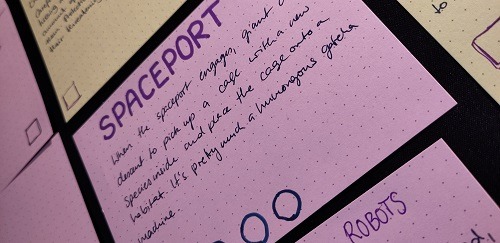
As someone who has a soft spot for the strange and uncanny, this was the perfect game to spend an evening or two on. Due to its nature, I’m definitely going to pick it up again and experience the menagerie through the eyes of yet another character. The machines just won’t let me go...
This might be your cup of coffee if...
you love sci-fi and doomed protagonists.
you enjoy making your own creatures.
you can appreciate intricate world-building and are not afraid to go to dark places.
you have too many damn index cards.
You can find the game HERE on itch.io! Make sure to listen to the inspirational soundtrack to set the mood. :)
1 note
·
View note
Photo

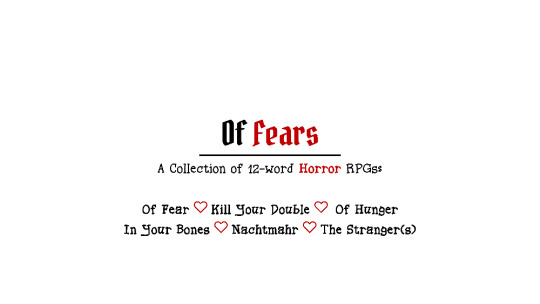

Made for the 12-word RPG Jam
This is a collection of six 12-word solo and two-player RPGs dealing with fear, body and trust issues as well as death. It is intended to have a generally unsettling atmosphere, verging on horror. The game also includes images of anatomical drawings (mostly bones/part of the skeleton as shown above, but also insides...which is why I’m avoiding posting all of them), however there is a "clean" version provided without them down below.
They're postcard sized and come with a backing - print them out and send them to a friend! Or someone you would like to curse.
You can find the full-size printable files for free on itch.io, HERE. Hope you get creeped out a little! 💀
#indie ttrpg#nano RPG#solo rpg#lyric game#two-player rpg#horror tw#bones tw#I had so much fun with 'Of Fear' I made a whole bunch sorry...#also still laying this out with PP...RIP
5 notes
·
View notes
Photo
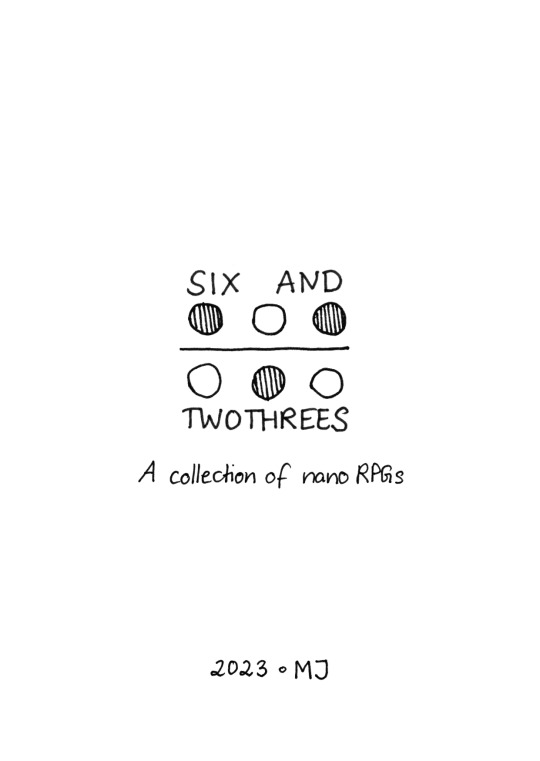



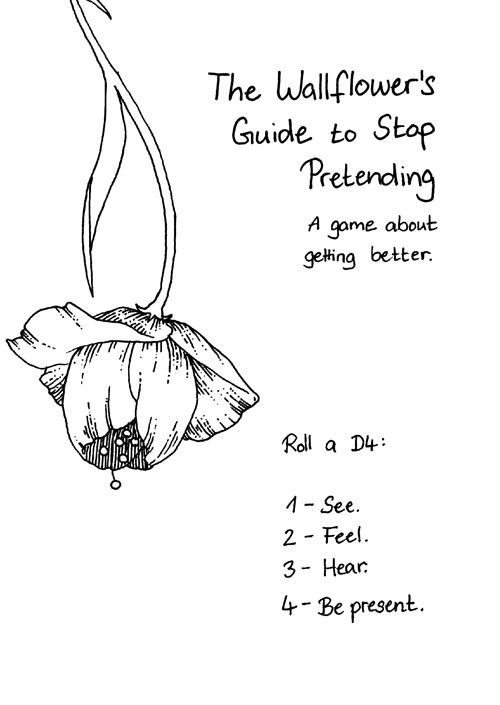
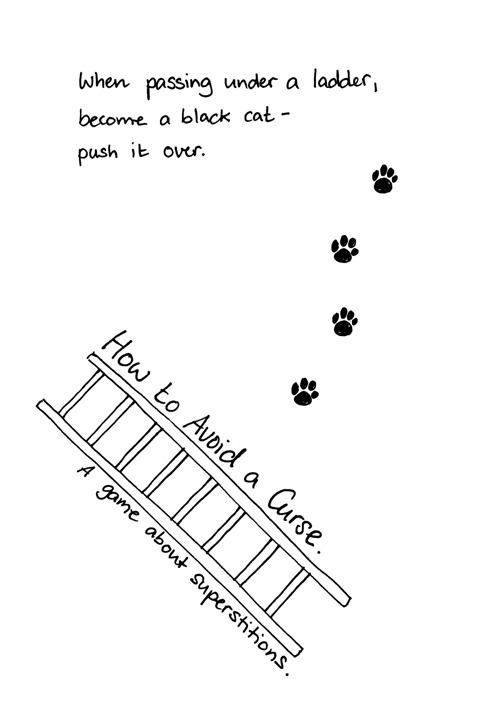
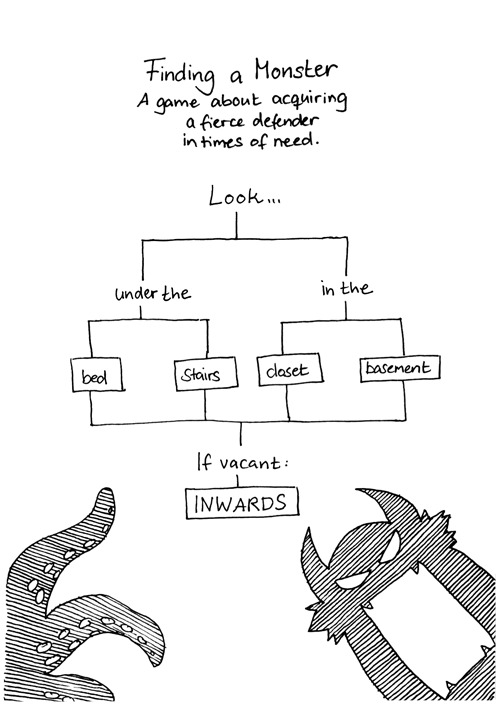
Made for the 12-word RPG Jam
This is a collection of six 12-word solo RPGs dealing with loss, self-reflection, depression and ultimately finding your inner strength. They're postcard sized and come with a backing - print them out and send them to a loved on!
Everything is hand-draw and handwritten, painstakingly scanned and cleaned and assembled. Most fun I’ve had in ages. :)
You can find the full-size printable files for free on itch.io, HERE. Hope you find some joy in them! Also: join the fun! The jam is open for another two months. Take care. <3
114 notes
·
View notes
Photo

Here’s a little nano-RPG for two players because I can’t stop making them ever since seeing @entwifeexperience‘s entry for the 12-word RPG Jam. I have some other ideas for an actual entry but when I woke up today my first thought was “but what about horror” (don’t know why that wasn’t my initial idea in the first place). So I might whip up some horror games, too. Just because.
Image used is public domain from Europeana.
42 notes
·
View notes
Text
Mini Reviews I
Here are some shorter horror games I’ve played over the last few weeks. It’s a dark season, friends.
Sanatorium Escape by Mychal Sanders
great use of horror elements in an interesting story format
play if you’re (not) afraid of the dark
multiple endings
You wake up in a strange, white room. A voice calls to you through the speaker by the door: “Good evening, Patient Zero.” A very tense, explorative solo adventure! The story is gripping and atmospheric, aided by the sometimes genuinely weird and scary prompts you carry out in your own home and the interesting format it’s presented in. Some commitment on your part is needed for it to unfold in all its glory, but it’s totally worth it. I was pleasantly surprised how much impact a small game like this can have on me. You’ll need a D6 to play and can either use a separate journal or write in the margins of the document (which is what I did). There is an accompanying playlist that goes nicely with the game. Ideal for those lonely weekend nights where nothing else is going on and you have an hour to spare.
Red Snow by John Thomas Battle
excellently thought-out layout and writing create a haunting atmosphere
kind of blurring into reality (beware!)
emotionally devastating :)
Snow, all around you. Except for that red patch over there. This managed to wring me out like a dish cloth in just a few minutes. Layout and writing make this game an experience to remember, the mechanics are brutal and heart-wrenching. It’s no joke to call this a survival-horror game despite it being quite short and simple (in the best way). Don’t expect an easy win or a happy ending - this is no feel-good adventure romp. You’ll need a couple of dice (d6, d4, d12, d20) and a piece of paper or notes app to play, although in this case I recommend paper for a more permanent feel. Mind that you play as yourself and that’s meant quite literally; some prompts will require you to weave in information from your life and immediate surroundings. Personally, I love how immersive this makes the game, but it can be a deal breaker for you. Note the soundtrack recommendation - it’s really good!
Bathrooms and Backrooms by Knighthouse co.
didn’t think backrooms could be funny but lo and behold
super short in-between game; easy to set up and play
need to mention how much i love the layout
Escape the office building of the LIMINAL Corporation in this one page solo rpg. Also, you really need to pee. This is a super short and fun “dungeon crawler” if you will; the mechanics are immediately clear, setup is a breeze and gameplay swift and satisfying. The short and sweet texts are well written and leave you wanting more. Using a suit from a standard deck of cards, you build your own random office layout to traverse. Rolling a D6 determines which of your three stats increases (Desperation, Navigation and Intuition) and if you can leave a room card face up to build your evacuation plan. There are multiple endings depending on what you manage to max out first - and it can get pretty close! I can see myself playing this more in the future.
0 notes
Photo



The Sticker Oracle - A Divination Game for the Sticker Jam hosted by Cassi Mothwin
Nothing’s worse than not knowing what the future has in store for you - this ends now! With the power of stickers and a strong faith in the randomness of the universe you, too, can transcend time and space and grab tomorrow by the shirt lapels.
Hey everyone, I slapped this little thing together (obsessively) within a few days and would love to get some feedback. Never made anything like it before and while I’m not interested in making it a “professional” thing (or monetize it in any way, shape or form), I do want to put something out there that is comprehensible.
So if you're interested in sacrificing a few minutes out of your day for me and give me some thoughts, download the first draft here (not print-friendly yet) and shoot me a DM later:
>>HERE<<
Thanks for reading and have a great day. <3
(And yeah I made this in PP...pls let me live.)
EDIT: Now links to itch.io. Everything else still applies. :3
#solo game#journaling game#solo journaling game#thestickerjam#indie ttrpg#ttrpg community#the sticker oracle
31 notes
·
View notes
Text
Field Guide to Memory
A keepsake game by Jeeyon Shim and Shing Yin Khor
Materials
game manual
journal
pen, art supplies
printer (if you want to use the ephemera provided)
some common items for one prompt or another (coin, leaf...)
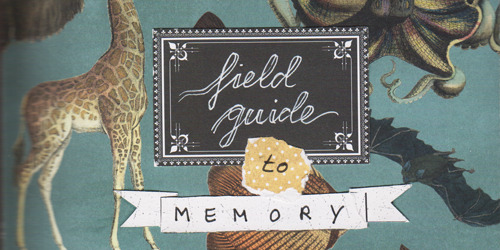
Premise
Accomplished cryptozoologist Dr. Elizabeth Lee has gone missing and is now declared dead five years after her disappearance. Her ongoing research on the Pronghorned Desert Rat remains unfinished and is currently held hostage by the Institute for Theoretical Evolutions. As her former student, you set out to finish what your mentor started to save these endangered critters and reconnect with Elizabeth and her legacy in all new ways - some surprising, some humbling, some devastating. This is a game about community and finding peace in the knowledge that no one ever truly leaves this world as long as they are remembered.
Mechanics
At the beginning, you use the character sheet to create your persona. Each in-game day then provides you with the next piece of the narrative as well as one or several prompts to journal about. Most of the prompts are presented as some sort of in-game correspondence or other ephemera/facsimiles for you to react to. You journal in three different categories, as given in each prompt: your diary, your field notes and your correspondence (each is basically exactly what you would expect from their name). If you take notes on cryptids, answer some official letters or reflect on your time with Dr. Lee, each journal entry brings you closer to the whereabouts of the Pronghorned Desert Rat. Some prompts bleed into your reality as the player - you might be asked to destroy parts of your journal or go outside to answer a prompt and gather materials. Bit by bit, you’re creating your own artifact, a chronicle of your efforts, as foreshadowed by the keepsake aspect of the game description.
Thoughts and Examples from my Playthrough
Field Guide was my first foray into solo games and a truly magical experience. The game has a very strong narrative, aided by a pleasant and engaging writing style that manages to feel consistent and still leave room for distinct character voices. You’re drawn further into the story by the lovingly designed ephemera and facsimiles, effortlessly fitting into the gorgeous layout of the game manual (which feels like a horrible name for something that is much more than just a guide for you to follow). Sitting down every day to answer prompts was always thrilling: What piece of Dr. Lee’s colourful past will be unveiled today? Which challenges lie ahead? Who is going to join my ranks of allies? Each journaling session was satisfying in a different way, each prompt unique and engaging.
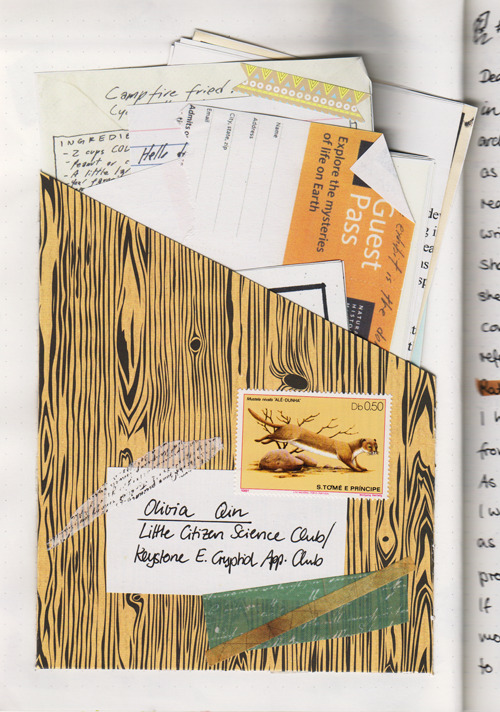
The simple yet elegant layout, the ephemera and the writing spark your creativity to create beautiful, clumsy, neat, human ephemera yourself. I haven’t drawn for a good while before I started to play and suddenly found myself doodling again without pressure or anxiety. You don’t need to be an artist - the game doesn’t judge your skills, only challenges you to try. If that’s not your cup of tea, there’s enough material to be printed and used as a base for your journaling. It might help to have some stickers, washi tape and similar stationary supplies at hand, but maybe your character prefers a simple black pen in a blank notebook.
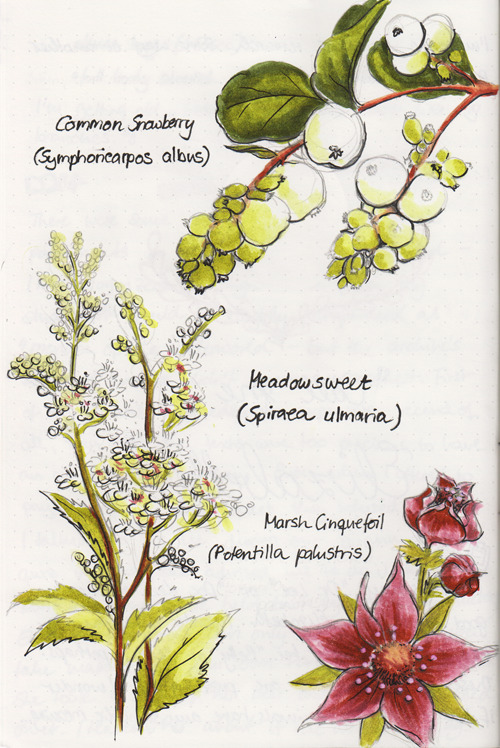
If you decide to play, you will be busy for a few weeks, at least. I do recommend you take your time, as intended by the game - it’s a much more lasting, reverberant experience and will stay with you for a good while after. Some of the “reality-breaking“ aspects had me wait on the next journaling session for a couple of days until I could do what the prompt asked me to - while you can always use your imagination, of course, I found the waiting time to be beneficiary to my game experience. It felt wonderful to finally get back into it, like I waited for a letter in the mail that finally came. Honestly, don’t rush it. And don’t worry if you leave the game to rest for a bit - it’s gonna marinate in your head and get even better. Linking the game to real-world places and experiences connects you that much more with your character and the story you’re building. I don’t think I’ll forget that day at the park although I was alone and the weather was terribly bleak - yet I enjoyed myself immensely.
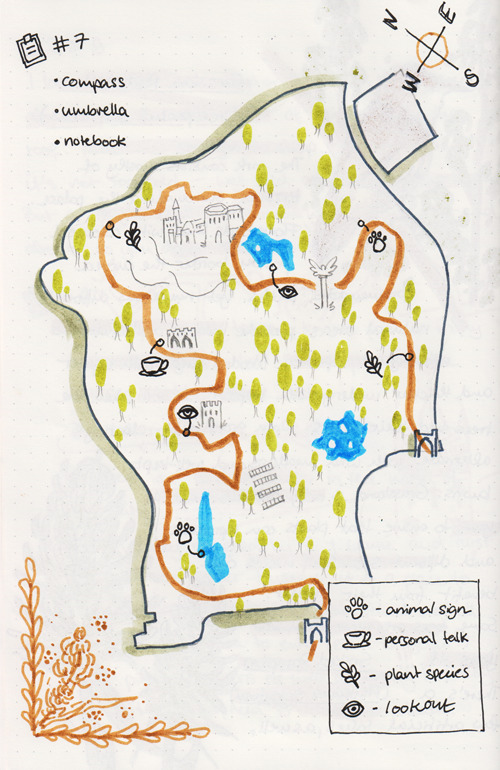
A lot of the gameplay relies on you getting introspective. You might reach into places that feel uncomfortable for you. While the mood in general is a lighter one, with bright memories of your mentor just as frequent as the more sombre ones, it can get pretty dark here and there. Personally, I liked these parts best, but if you’re looking for an overall fluffy and happy adventure, this might not be for you. I’m not ashamed to admit that I cried a little at the end.
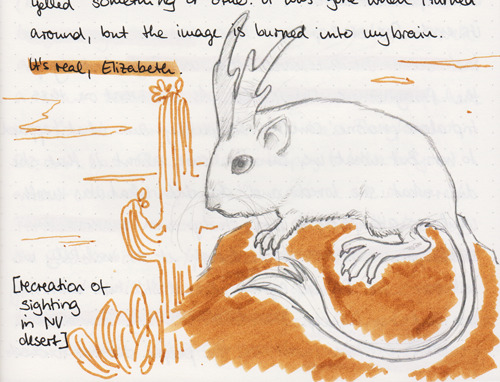
Finally, the cryptids! There’s of course the Pronghorned Desert Rat, a small horned critter on the verge of extinction (according to Dr. Lee). If you are not able to attach yourself to your late mentor, these wee guys will motivate you to keep going. Learning about them, their behaviours and characteristics, was some of the most intriguing things about the game. With them come a few more cryptids that are part of their ecosystem and a few others you will have to explore or make up yourself, as well as - light spoiler! - some sexy cryptid costumes for a burlesque show. The concept of the ecosystem is also adapted to describe the community you build to achieve Dr. Lee’s goal. The theme of connection is weaved strongly into every aspect of the narrative and gameplay, so much so that you begin to think of it even at times you’re not playing. What makes a community? I think that is one of the question the game wants you to find an answer to.

Even though you have plenty of creative freedom to answer your prompts during the game, the narrative is mostly linear. There’s a predetermined ending that you can embellish to your liking and will be different for each player, but I reckon a second playthrough for the same player, even with a new character, wouldn’t differ significantly and isn’t necessarily worth it. That being said, the time you spend with it is plenty and I find the game worth the cost for what it is.
This might be your cup of coffee if...
you prefer to be guided in your solo adventures.
you enjoy a well-designed manual full of fake memorabilia and ephemera to use in your journal.
you’ve always wanted to be a cryptozoologist.
you take pleasure in exploring a character in-depth, especially in relation to other characters and how they impacted yours.
you are open to experimental mechanics.
You can find the game on itch.io. Both creators also have their own patreon - your support garners you access to some of their smaller projects, which are also worth a look!
#solo rpg#review#journal#long#beginner friendly#reality encroaching#keepsake#drawing#drama#field guide to memory
15 notes
·
View notes
Text
The Sticker Game
An alternate reality audio drama and journaling game by Cassi Mothwin
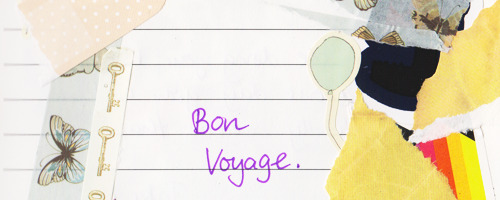
Materials
operational document
accompanying audio drama
stickers
journal
Premise
Help a mysterious agency study alternate realities. Connect to another you by following the instructions of your guide and placing stickers in your journal to examine the effects your actions have on them and their world. Have you minded the instructions carefully? Yes? Then you will have nothing to worry about. Happy sciencing!
Mechanics
You listen to a recording provided to you by the agency, providing prompts from your guide to lead you through every step of the experiment. It’s basically an audio drama that sets up and accompanies your game with all the usual trappings. Follow the instructions of the guide and place your stickers in your journal - that’s it! What sounds like a simple game is a simple game. No dice, tables, cards or other special tools needed.
Thoughts and Examples from my Playthrough
At some point, are we going to run out of words to describe the wonderfully weird, multimedia-based games being created? Or is the description at the top simply going to have to get longer to accommodate the scope of them? It probably doesn’t matter and you should instead focus on letting the excellently produced narrative carry you through a whacky 2-hour-journey of alternate dimensions, your pile of unused stickers and gentle self-reflection.

Listening to the audio feels very immersive and I found myself reacting and responding to the guide’s witty dialogue (monologue?) throughout the game. While it is funny and absurd at times, the humour is subtle and not jarring. The amount of time given for each audio prompt is long enough to select and place your stickers, leaving some room for additional doodles and notes if desired. Of course there’s always the option to stop or loop a track to give yourself even more space to create, however I did enjoy a bit of crunch to avoid getting lost in my own thoughts in between prompts. Truly, the game shines when you treat it less like a full-blown journaling game and let your stickers “speak” for you. The further the game progressed, the less inclined I felt to grab my pen and I was better for it.

To be completely honest, it took me a few prompts to let myself relax and enjoy the experience fully. If you’re a true sticker hoarder, this might not be easy at first. I promise though: somewhere in the middle of this game you will run into a freeing sensation of giddiness, as if you entered a portal back to your childhood days where putting a sticker down wasn’t a form of loss but an act of creation and joy. Even if you don’t, it’s as easy as pausing the audio and taking a break or stopping altogether - as with all solo games, it’s always in your hands to navigate the game as you wish.

If I may give one piece of advice: should you have a lot of sticker sheets and fewer individual stickers, cut up your sheets beforehand. Some prompts will be much easier when you have individual stickers. It’s also just fun to have them all on a pile to rummage through.
True to the alternate reality theme, it’s entirely possible to change the materials of your game to your liking. I’ve seen a playthrough using gifs and html on a web page - your imagination is your limit.
The game is highly accommodating, providing a full transcript as well as a cheat sheet with the spoken instructions slightly simplified and shortened. The manual’s design is simple and compelling, easy to read and pleasant to look at. Overall, an incredibly well-rounded game that I’m immensely impatient to try in a group setting.
This might be your cup of coffee if...
you hoard stickers. Use them. Uuuse theeem! This might even cure you of sticker anxiety (no promises).
you want a relatively short and sweet experience that is nevertheless highly engaging and story-driven.
you enjoy being put on the spot a little and challenged to improvise.
you have just a few pages in a journal left to fill and no idea what to put in it.
You can get it on itch.io or DriveThruRPG! :)
22 notes
·
View notes